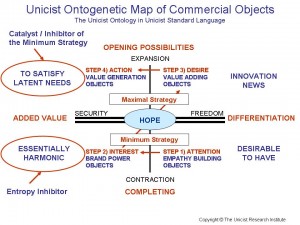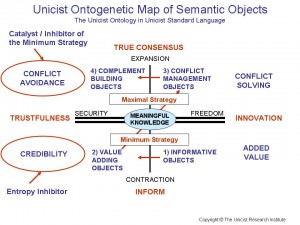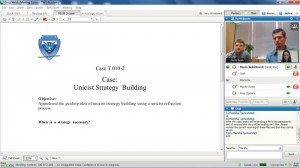The future scenario for Object Driven Marketing was developed by the Future Research Lab of The Unicist Research Institute, led by Peter Belohlavek, to provide information on the next step in marketing in the XXI Century. The following synthesis of the results of the research shows what is already happening in the market and how these actions will evolve due to the use of the technologies that are now available. Object Driven Marketing implies transforming the activity of marketing managers from a technical analytical role to an architectural role.
To access the basics on Unicist Future Research please enter: www.unicist.org/sdp.shtml
Introduction
Commercial objects are homologous to the autopilot of an airplane. They are automated adaptive units to influence the marketing having a scope within which they are functional. When the scope is exceeded it is necessary that the managers assume the responsibility to influence the market with other means.

The reach of one’s globalization is defined
by the limit of the pronoun “WE”…
Merchandising, packaging and promotion can be considered as some of the predecessors of commercial objects. Object driven marketing is just the materialization of traditional marketing mix in a structured adaptive commercial process.
But this process requires being able to emulate in mind the structure of the different segments that are addressed in a commercial process. This requires the use of models that make this possible in a reasonable, understandable and provable way.
Unfortunately, the proof can only be confirmed when the market has been approached. That is why object driven marketing requires a full credibility in what is being done.
Object driven marketing integrates commercial driving objects to influence buying decisions, entropy inhibitors to avoid losing clients, catalysts to influence the commercial process and gravitational object to sustain the value propositions. Inhibiting objects are used to avoid dysfunctional commercial activities.
The drivers towards object driven marketing are:
- The customer relationship management systems
- Supply driven or highly competitive markets
- Global marketing
- The market orientation of companies
The new technologies that make object driven marketing possible are:
- Adaptive IT solutions
- Internet
- Consumer behavior segmentation
- Corporate behavior segmentation
- Commercial Objects
- Semantic and Semiotic objects
- Unicist Ontology of Ambiguous Language
- Adaptive automation
What will have happened during the next 10 years?
- The effectiveness of marketing campaigns will have been notoriously increased
- Global marketing will have become fully objects driven
- CRM will have become adaptive
- Diving objects will be regularly used
- Catalysts will be used by the market segments leaders
- The relative commercial cost will have been significantly reduced
- The role of marketing managers will be focused on marketing architecture
- The expansion of markets beyond the boundaries of an existing business will have been simplified.
“Adaptiveness is the name of the new Era”
The Role of the Architect
Architects can only design and monitor the construction of something that is being built if they have the functional model in their minds. Architecture begins being a mind model and ends integrated in a deed.
The role of the architect includes necessarily the integration of both the science and the technology that architects need to manage.
Art is what makes the integration of science and technology possible. In this sense, architects need to integrate both science and technology considering that the scientific knowledge they manage is essentially objective and the technologies are driven by the values of those who developed them.
Architecture requires a high level of knowledge in order to integrate the objective value, the subjective value and the environment in a unified field. It has to be considered that the etymology of architects implies “director of works”.
Architects need to build a functional model that represents the object that will be constructed.
This functional model requires having apprehended the ontological functionality of reality, having developed a strategy that includes both maximal strategies, to expand the functionality of the object that has been built based on the knowledge of its unified field, and minimum strategies, to ensure the functionality of the model.
Object Driven Marketing:
Comercial Objects
Unicist commercial objects are adaptive systems that have been developed to install ideas in the mind of the potential customers. These ideas need to follow the steps of object driven marketing
 The goal of commercial objects is to manage commercial processes of supply driven markets.
The goal of commercial objects is to manage commercial processes of supply driven markets.
This implies that they have been designed to sustain the marketing process of products and services that are being proposed and not just respond to the demand of a market.
They deal with all the markets where there is a differentiation of the value proposition. Commercial objects work as an autopilot; under normal conditions they manage the process of helping customers in their buying processes.
By definition they are extremely segmented, which means they consider each segment as a different universe in order to have the capacity to exert influence on them.
About the Unicist Commercial Objects
The purpose of a commercial object is to install “hope” in the mind of the potential customer. This hope is related to finding the solution for a latent need s/he has that is arising driven by the commercial proposition that is being made.
 But commercial objects actually begin to work as such when they awaken the interest in the value proposition that satisfies the latent needs. This implies that the commercial objects have been designed based on a true knowledge of the segment that is being approached, its needs and beliefs.
But commercial objects actually begin to work as such when they awaken the interest in the value proposition that satisfies the latent needs. This implies that the commercial objects have been designed based on a true knowledge of the segment that is being approached, its needs and beliefs.
In supply driven markets the knowledge of what the segments believe is basic because people need to believe in order to see a previously inexistent solution.
While demand driven markets are based on “seeing to believe”, supply driven markets are organized for people who accept that they need to “believe to see”.
The materialization of the value propositions has to happen within the accepted myths of a culture in order to be accepted.
The development of commercial objects needs to include an adequate use of semantic objects and semiotic signs to install the necessary ideas in the mind of the segments that allow them to perceive the solution that is being proposed.
The purpose to be achieved by the commercial objects is to “install hope” that a new solution will satisfy a latent need for the potential buyers. For this purpose it is necessary that the segment discovers that the solution proposed allows them to overcome adverse conditions in some environment.
The Functionality of Unicist Commercial Objects
 There are four types of commercial objects that establish the steps that need to be followed for their use in the object driven marketing process.
There are four types of commercial objects that establish the steps that need to be followed for their use in the object driven marketing process.
1) Step 1: Empathy building objects
2) Step 2: Brand power objects
3) Step 3: Value adding objects
4) Step 4: Value generation objects
Step 1: Empathy Building Object
The first step is the use of objects that provide solutions to the latent needs of the potential customers.
These objects need to be aesthetic so people feel the need to have them.
The “what for” of the value proposition is the core of the empathy building object.
Their functionality has been achieved when the potential customers have transformed their latent needs into an analogy that arise their interest.
Step 2: Brand Power Objects
Once a potential interest has been achieved, it becomes necessary to confirm the reliability of the proposal. This requires confirming the added value that is included in the value proposal sustaining it with the corresponding attributes deposited on the brand.
The functionality of brand power objects has been achieved when the potential customers feel the desire to “own” the value proposition.
Step 3) Value Adding Objects
Value adding objects deliver the value that is included in a proposal that covers a latent need. As such, it is necessarily an innovation for the potential customer. Value adding objects have been designed to manage the authority conflicts produced by the innovations. They use conflict management semantic objects and are based on a mind opening figurative communication and on objective information.
Their functionality has been achieved when the potential customer has bought the idea of the value added by the innovation included in the value proposition.
Step 4) Value Generation Objects
Value generation objects integrate complementation building semantic objects and value adding semiotic signs. They need to be based on a homology driven figurative communication and include a message that opens and expands the possibilities of the individual.
Their functionality has been achieved when the potential customers discover that the complementation reinforces their own value and they remain in power of their activity.
Commercial Objects Building
R&D Market Labs build and/or use commercial objects in order to drive, catalyze or inhibit the entropy of specific aspects of the business processes. A commercial object is an encapsulated adaptive process that has been designed to generate value within a commercial process. It has a feedback and quality assurance mechanism to make it fully reliable. It is used within commercial processes to save energy, minimize conflicts, maximize influence and as a basic auto-pilot to manage the feedback from the market.
Basically, the commercial object driven processes use:
- Driving Objects
- Semantic Objects
- Semiotic Objects
- Entropy Inhibiting Objects
- Catalyzing Objects
1) Driving objects that deal with the operational aspects of buying processes.
They centrally define the functionality of a product or service. The products or services can be included or not in these objects.
 They are the objects that provide the “proof” of the functional value of what is being proposed. In the marketing process they are integrated with semantic objects and with semiotic objects in order to increase the influence on the potential client.
They are the objects that provide the “proof” of the functional value of what is being proposed. In the marketing process they are integrated with semantic objects and with semiotic objects in order to increase the influence on the potential client.
2) Semantic objects that deal with the communicative aspects of a buying process.
They are integrated by different objects that allow managing the communication following a plan A, when the complementation is natural, a plan B, when it is necessary to exert more influence on the mind of the buyer, and a plan C, when a high level of innovation is implicit in the buying decision.
The goal of these objects is to install the idea of the concept of the value proposition in the mind of the potential customer.
 3) Semiotic objects that deal with the guidance of the potential customer during the buying process.
3) Semiotic objects that deal with the guidance of the potential customer during the buying process.
They guide customers towards a buying decision and also manage the denotation of what is being proposed with the connotation that is “between the lines” of the value proposition.
The guidance is based on the effectiveness of the communication provided by the semantic objects and begins with the identification of what the value proposition is about and ends with the building of product synergy guiding towards the concept that sustains it.
4) Entropy inhibiting objects that are behind the buying processes. They sustain the stability of the relationship with customers and clients.
Their main goal is to ensure the satisfaction of the value promises and the needs of the customers. They focus on the functional relationship with customers and clients monitoring this process in order to ensure its stability.
They imply institutional actions to build a common functional space. They use virtual tools like networks, forums and similar ways to integrate participants based on a functional greater good.
5) Catalyzing objects that accelerate buying processes. They are based on the influential power of elements that expand the possibilities of the potential buyers.
Catalysts cannot be part of the marketing process; they need to be beyond it, they are part of the context of the business. They have to be preinstalled in the business context in order to be used without generating resistance in the environment.
They are not credible when they are built for a certain commercial purpose. They are perceived as a manipulation.
They need to have a “perfect” timing with the needs of the client. They need to have an extreme aesthetics and credibility in order to be able to influence the context of the business.
Adaptiveness Requires Segmentation
Developing adaptive marketing approaches demands developing segmentations that allow influencing the market considering the functional aspects, the relationship (psychological) aspects, the conceptual aspects that define the attitude of the segment and the lifestyle aspects that define their final intentions.
B2C Segmentation
 Functional segmentation
Functional segmentation
Functionality is defined as the capacity of something to fill an individual’s need.
Functionality is homologous to aesthetics. When talking about functionality we refer to the perceived functionality which defines what we call the hard segmentation.
Psychological segmentation
It is the segmentation that defines the type of relation an individual has with a product/service. An individual adapts to reality within limits. Psychology established the limits of an individual’s context.
Conceptual segmentation
The conceptual market segmentation describes the nature of a product as perceived by the market. Conceptual market segmentation describes the concept that is implicit in a product or service.
These three segmentations need to work within the context of the corresponding lifestyle segmentation.
B2B Segmentation
The monitoring process considers 3 levels of structural segmentations and the context:
Level 1)
- Competitive positioning
- Conceptual Product/Service segmentation
- Link building segmentation
Level 2)
- Customer’s positioning segmentation
- Brand attributes segmentation
- Customer’s culture segmentation
Level 3)
- Functional Segmentation
- Relationship Segmentation
- Conceptual Segmentation
The Context
The type of market is considered as a context for the business. This implies that it is an input to evaluate.
Conclusion
Object driven marketing is the consequence of the maturity of commercial processes. It allows using adaptive automation to deal with different segments in global and local markets based on the adaptiveness included in the objects that are being used.
This approach is necessary for supply driven markets, innovations, market expansion and extreme competition. Object driven marketing implies the use of segmentation models that allow dealing with the functional needs, the attitudes and the intentions of the buyers.
Object driven marketing is an architectural approach to improve the utility, aesthetics and solidity of the commercial processes.
If you want to access more information about this study please contact n.i.brown@unicist.org
Unicist Press Committee
NOTE: The Unicist Research Institute was the pioneer in complexity science research and became a private global decentralized leading research organization in the field of human adaptive systems. http://www.unicist.org
 When the products that have been launched do not belong to an existent category and satisfy non manifested needs, the confrontation of conquest begins with the weakening of some occupied niches to introduce the new product (guerrilla confrontation).
When the products that have been launched do not belong to an existent category and satisfy non manifested needs, the confrontation of conquest begins with the weakening of some occupied niches to introduce the new product (guerrilla confrontation).











